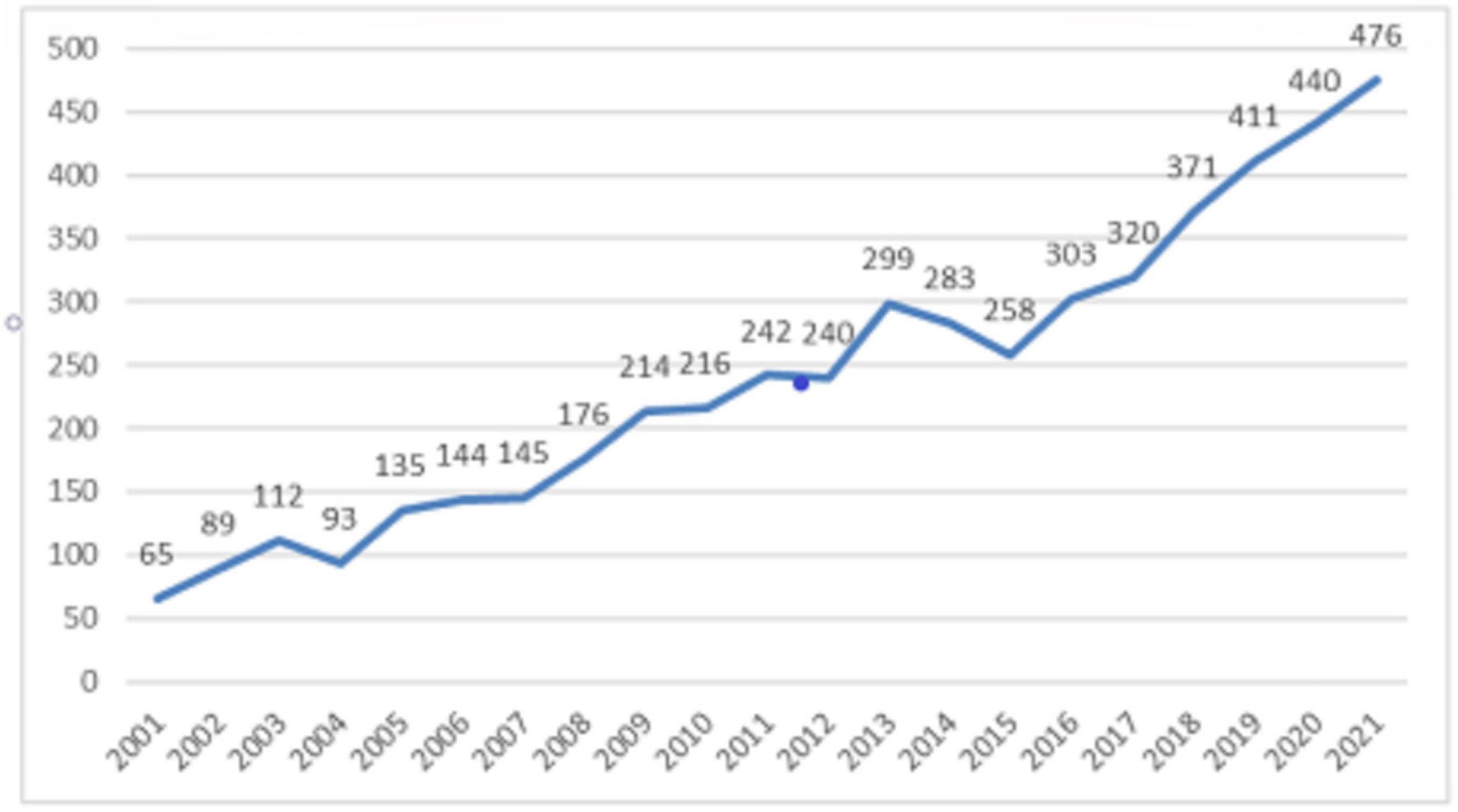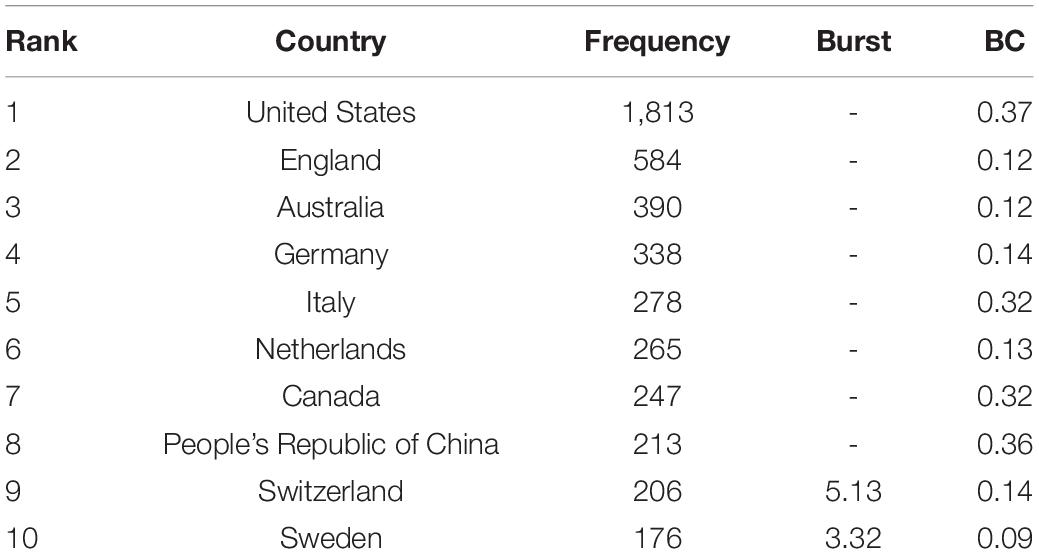- 1Department of Cardiovascular Diseases, Guang’anmen Hospital, China Academy of Chinese Medical Sciences, Beijing, China
- 2Graduate School of Beijing University of Chinese Medicine, Beijing, China
The aim of this study was to gain insight into the progress and dynamics of psycho-cardiological disease research and track its hot spots. We have analyzed psycho-cardiological disease-related literature extracted from the Web of Science (WOS) Core Collection from 2001 to 2021 with the help of Cite Space. As a result, we have included 5,032 records. Then, we have analyzed connected networks for the country, author, subject category, keywords, and cited reference. We have summarized the findings in four aspects. First, the annual quantitative distribution of publications is on the rise, although there is a slight drop. Second, in terms of country analysis, the United States, England, Australia, Germany, and Italy are the main research forces in psycho-cardiological diseases. At the same time, several academic entities represented by Andrew Steptoe and Roland von Känel, MD, have been formed based on the early consciousness of physical and mental health in these countries. Besides, China is also more concerned about it due to the rapid population aging process and the largest population. Third, the psycho-cardiological disease is multidisciplinary, including psychology, psychiatry, clinical medicine, such as cardiovascular system and neurology, public environmental and occupational health, and pharmacology. Finally, the results of keyword analysis and co-cited references indicate the hot spots and frontiers in psycho-cardiological disease. The hot spots in psycho-cardiological disease include three aspects. The first aspect includes psychosocial factors, such as depression, lack of social support, and low economic and social status; the second aspect includes priority populations, such as Alzheimer’s disease dementia caregivers, elderly, and patients with cancer, and the third aspect includes interventions, such as exercise therapy and diet. In addition, there are three future research frontiers. The first is a psycho-cardiological disease in patients with COVID-19; the second is cardiac rehabilitation, especially exercise therapy and health behavior evaluation; and the final is evidence-based medical evaluation, such as systematic reviews and meta-analyses.
Introduction
Cardiovascular diseases (CVDs) and mental illnesses have become the two major severe diseases impacting human physical and psychological health. When CVDs or symptoms and psychological disorders are present together, they are called psycho-cardiological disease (1). CVDs remain a primary reason for disability and early death worldwide (2). In disability-adjusted life years (DALYs), ischemic heart disease and stroke rank first and third, respectively, in the global burden of disease (3). In the United States, CVDs lead to health and economic burdens (4). The reported cost of treatment for CVDs in the United States in 2015 was US$213 billion (5). According to estimates, the cost of treating obesity and diabetes, both of which put people at risk for CVDs, was US$149 billion and US$237 billion per year, respectively (6, 7). In China, as issued in the official Report on Cardiovascular Diseases in 2017 by the National Center for CVDs, there were 290 million patients with CVDs (8). However, people pay less attention to the interdependence of mental health and CVDs (1). Related studies have shown a double causal link between negative emotions and CVDs.
The symptoms of CVDs may be triggered or exacerbated by negative emotions. Evidence shows that major depression was responsible for almost 4 million estimated ischemic heart disease DALYs) in 2010 globally (9). According to the data supplied, in Korea, the incidence of ischemic heart disease increased by 38% among older adults exposed to depression (10). Besides, depression is associated with increased cardiovascular adverse events, such as myocardial infarction and heart failure. In addition, recent data demonstrate that genetic risk factors for major depressive disorder (MDD) and loneliness multiply the risk of CAD in women (11). Moreover, CVDs can also contribute to psychological health problems. Depression occurs in one in five patients with coronary artery disease, peripheral artery disease, or heart failure (12). Men or women with CVDs are at high risk of stress, depression, and suicidal ideation (13). Some current research indicates that patients with heart failure are more likely to have ongoing anxiety during hospitalization and poor quality of life (14, 15). Depression and anxiety are common in atrial fibrillation and atrial flutter (16, 17).
The CVDs and mental illnesses are inextricably linked but have low clinical diagnosis rate. A retrospective analysis of 132 cases concludes that the clinical detection rate of psycho-cardiological disease was very low (1). Therefore, it is essential to pay more attention to the psycho-cardiological disease. The current distribution of literature on psycho-cardiological disease is relatively fragmented, which prevents medical practitioners interested in this field from having a comprehensive and intuitive understanding of the current status and trends of psycho-cardiological disease research in the international arena. The Cite Space software is visualization software that mainly intuitively displays the hot and cutting-edge knowledge in a specific subject field in the form of a knowledge map. There have been knowledge mapping studies of atrial fibrillation, coronary heart disease, and depression or anxiety (18, 19). Still, there have been no knowledge mapping studies at a holistic level between CVDs (e.g., coronary heart disease, atrial fibrillation, hypertension, and heart failure) and psychological diseases (e.g., depression, anxiety, and stressful trauma).
Therefore, this article visually analyzes the relevant literature on psycho-cardiological disease gained from the Web of Science (WOS) Core Collection database between January 2001 and December 2021. Based on the scientific knowledge map of psycho-cardiological disease, we have provided the research trends and hot issues in this field for related researchers.
Materials and Methods
Data Source
WOS Core Collection1 was used to obtain the publications, and the retrieval strategy was [TS = (“cardiovascular disease” AND “psychological disease” OR “Bi-heart disease” OR “psycho-cardiological disease”)] AND [language = (English)] AND [article type = (article AND reviews)] AND [Time span = (January 2001 to December 2021)]. A total of 5,032 results were included by excluding incomplete or unpublished literature, such as conference abstracts and conference papers, according to the classification tags of WOS. Later, we imported the titles, authors, abstracts, keywords, and cited references into Cite Space 5.8.R3, a scientific knowledge mapping analysis tool.
Research Methods
After importing the literature data from the WOS data download into Cite Space 5.8.R3, deduplication was performed first. After running the deduplication program, there were no duplicates in the literature included in this study, and the original data could be used directly for subsequent analysis. The results were presented in a visual map, and nodes were the sign of analyzed items. The greater the node range, the more frequently the object appeared or the more citations there were. The thickness of the lines connecting nodes indicates the degree of co-occurrence or co-citation (20). Besides, betweenness centrality (BC), performed in purple in the knowledge map, was introduced in order to evaluate the importance of a node in the network and its value was between 0 and 1. It is generally considered that BC, with a value greater than 0.1, is a central medium (21). The bigger the size of the node, the higher the centrality. Furthermore, clustering is another way of analyzing the research domains by reflecting a unique theme. Finally, burst detection captured events’ burstness with certain features rising sharply in frequency. Therefore, the limitation of just addressing the cumulative number of metrics to measure an entity’s influence can be overcome (22).
In this study, country, author, category, keywords, and references were selected as the research items, and the time span was 2001–2021. Each year is a time slice. Links with strength set to cosine and scope set to within slices, and the 50 nodes with the highest frequency in each time period were also selected (top N = 50); the network using the pathfinder algorithm was pruned, and the rest of the settings were default parameters. The visualization plots and tables in stages were drawn.
Results
Analysis of Annual Distribution of Publication
The annual quantitative distribution of publications is one of the significant signs to explain the development trend of a specific field (23), i.e., the yearly publications of research on the psycho-cardiological disease, as shown in Figure 1. The graph reveals a steady rise in the number of psycho-cardiological disease-related literature on the whole between 2001 and 2021, although there is a slight drop. As shown in Figure 1, there is an increasing trend in the amount of literature published after 2008 compared to before. In addition, it reached a small peak in 2014. In conclusion, more emphasis has been put on psycho-cardiological diseases, and an increasing number of relevant studies are underway. People are increasingly conscious of their physical and mental health.
Analysis of Country Ranking and Co-author
Knowledge maps can provide information about significant countries and productive teams for relevant medical researchers and then can contribute to their collaboration (24). As depicted in Table 1, the United States, England, Australia, Germany, and Italy are the most influential countries for psycho-cardiological disease, not only in terms of the number of co-author papers but also in higher ranked centrality. China, with the second high degree BC, stands out in this table. A rapid aging population speed and the largest older population may have promoted the increased BC in this article (25, 26). Population aging has become a significant challenge in the world, both in developed and developing countries. Older adults often face challenges with their physical, mental, cognitive, and social health. The growing number of older adults suffering from hypertension, particularly with complications, is susceptible to coexisting depression disorders, such as depression or anxiety. In addition, 8.5–27.3% of people with diabetes suffer from depression (27). Related studies find that depression is prevalent in institutionalized older adults (28, 29). Therefore, clinicians should pay more attention to the psychological problems of older people with CVDs.
Meanwhile, several academic entities have been formed based on the early consciousness of physical and mental health in these countries (displayed in Table 2). Andrew Steptoe, Professor of Epidemiology and Public Health at UCL, believes that acute stress disorders can increase cardiac disease events (30). For example, depression, a cause of acute coronary syndrome, is also an accompanying symptom (31, 32). Roland von Känel, MD, with the highest degree of BC, a professor of Medicine and Head Division of Psychosomatic Medicine at University Hospital Bern, is a critical author in promoting the development of psycho-cardiological disease. He declares that there is an interaction between psychosocial risk factors, such as anxiety, depression, stress, and CVDs (33). Besides, he is devoted to conduct a series of clinical trials, such as on dementia caregivers with an increased inflammation marker and a higher risk of suffering from CVDs (34, 35). More importantly, he advocates the inclusion of psychosocial risk factors in cardiac rehabilitation (33). However, Figure 2 shows that the links between the nodes representing countries are more fragmented, and the connections between the nodes representing authors are stronger. Above these indicate relatively less collaboration and weak linkage between countries in psycho-cardiological disease.
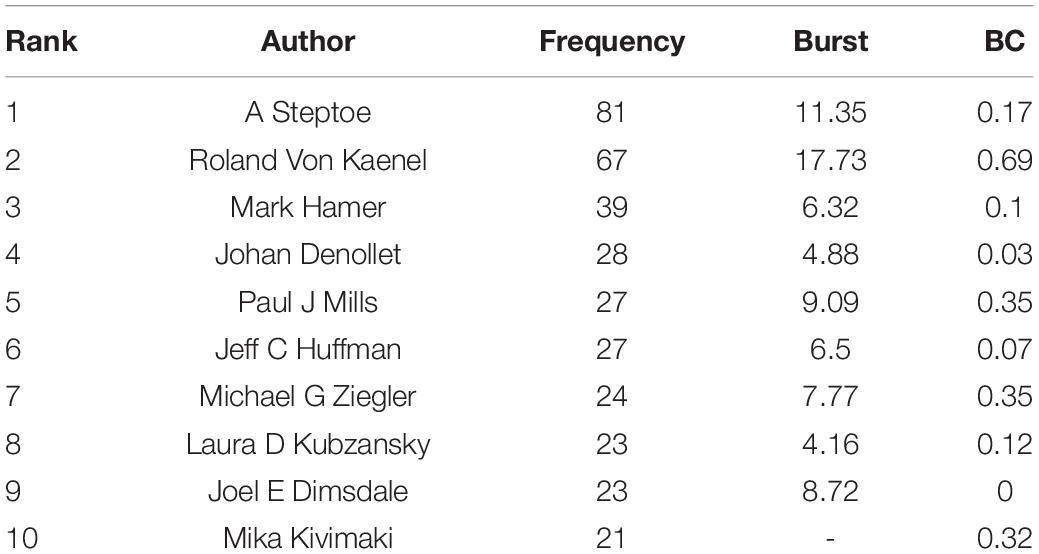
Table 2. Top 10 productive authors of publications about the psycho-cardiological disease and related literature.
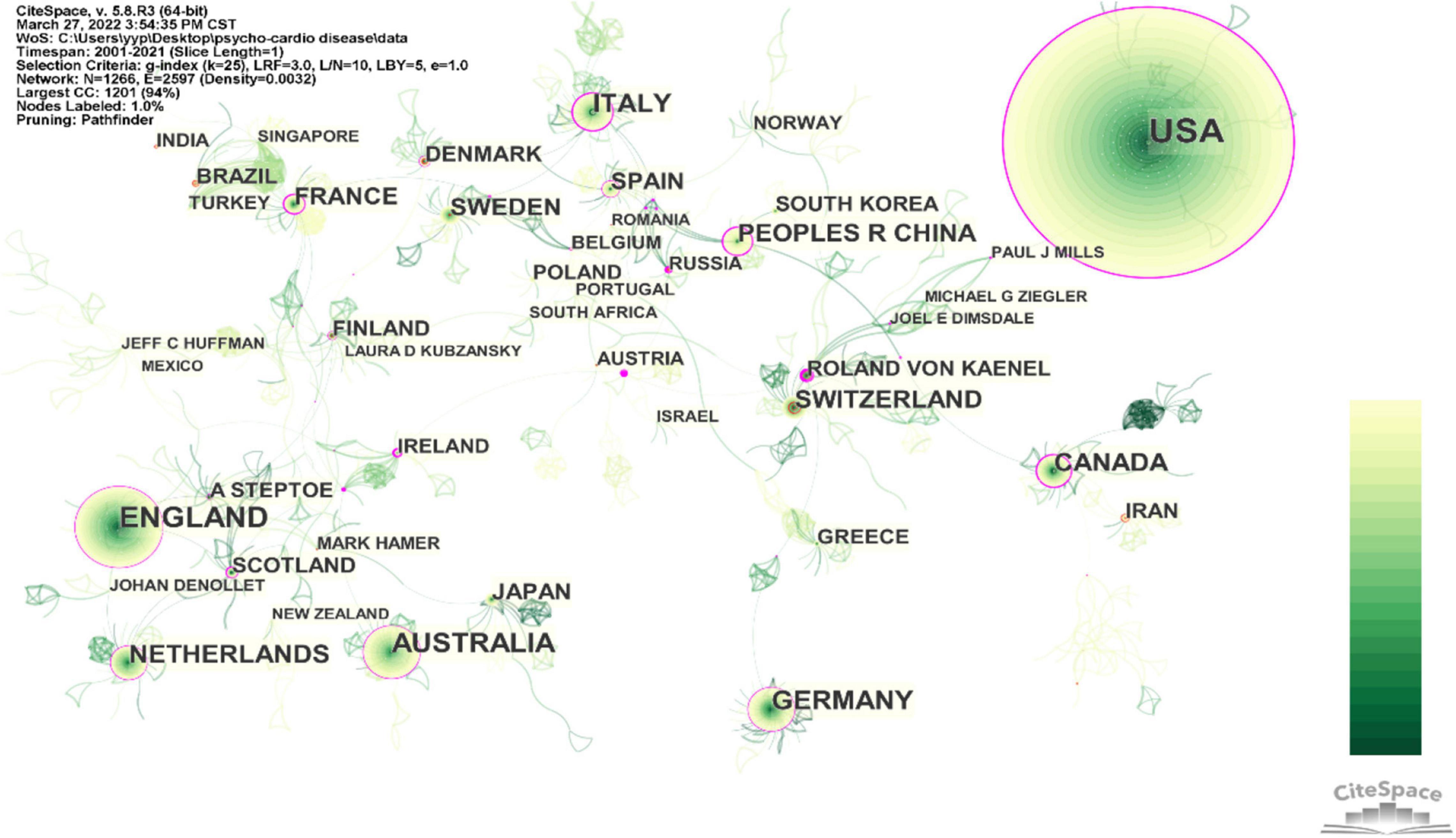
Figure 2. Countries–authors hybrid network of publications about the psycho-cardiological disease and related literature.
Analysis of Subject Categories’ Co-occurrence
The subject category of an article can also be regarded as evidence of a high degree of concentration in this article (22). Figure 3 expresses the subject category’s coexistence of psycho-cardiological diseases and allied research publications. As described in Figure 3, PSYCHOLOGY, PSYCHIATRY, CARDIOVASCULAR SYSTEM and CARDIOLOGY, PUBLIC, ENVIRONMENTAL and OCCUPATIONAL HEALTH, NEUROSCIENCES and NEUROLOGY, GENERAL and INTERNAL MEDICINE, ENDOCRINOLOGY and METABOLISM, and NEUROSCIENCES are noticed in Table 3. Based on these observations, we have argued that psycho-cardiological diseases’ research is multidisciplinary, belonging to the biological, psychological, and social medical model. There are varying degrees of association between bi-heart diseases and many disciplines. Psychology and clinical medicine have the highest participation, followed by public health management. The figure’s nodes of physiology, neuroscience, pharmacology, and psychiatry are marked with purple circles (BC is greater than 0.1), showing that they are worthy of attention and influential disciplines. In addition, neuroscience and behavioral sciences marked by red rings have positive burst detection, suggesting that they are popular for a certain period.
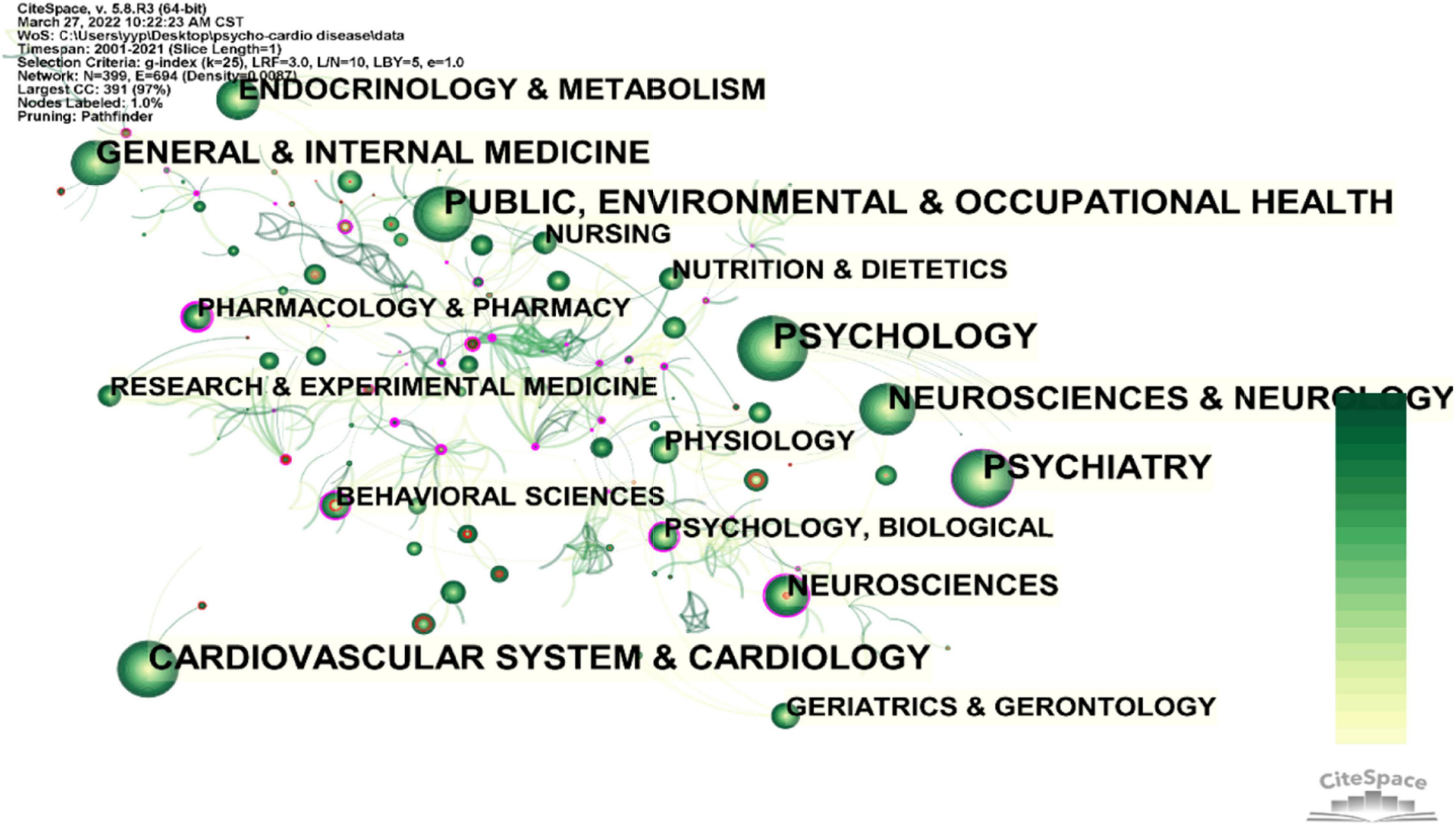
Figure 3. Subject category coexistence of publications about the psycho-cardiological disease and related literature.
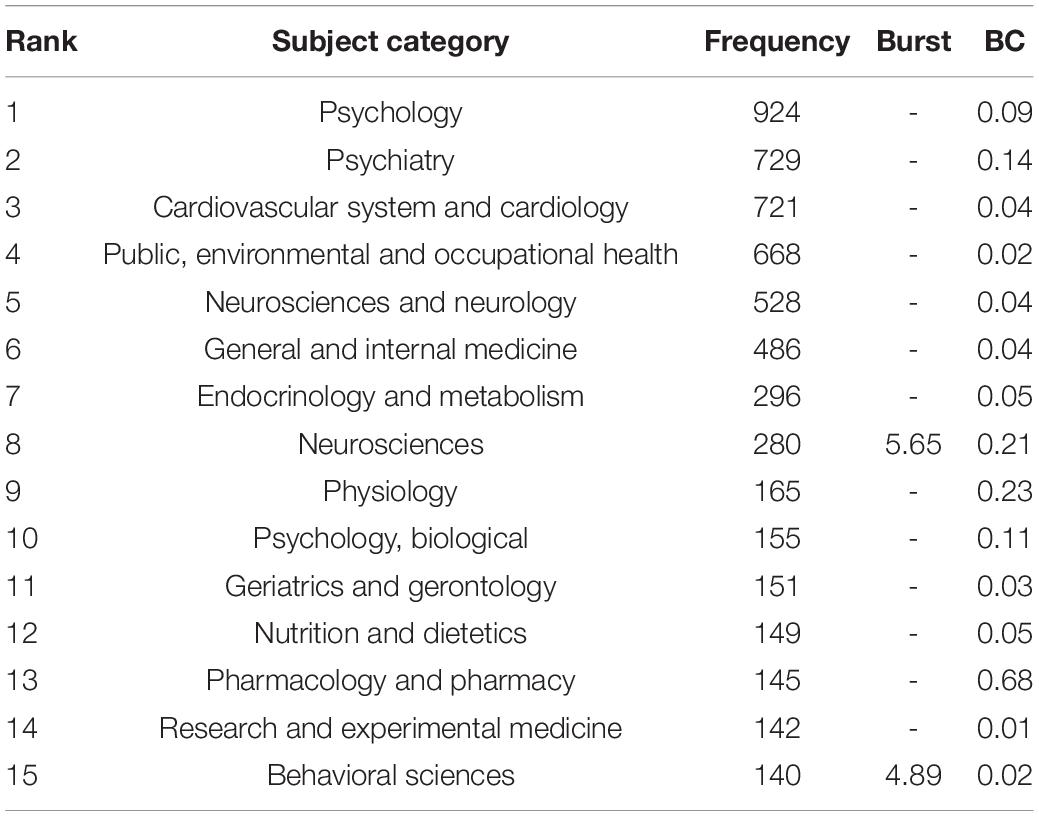
Table 3. Top 15 subject categories of publications about the psycho-cardiological disease and related literature.
The first burst detection is neuroscience. Perhaps, because the population in the world is aging rapidly, the number of older adults with Alzheimer’s dementia is gradually increasing. Evidence shows that there will be more than 13.8 million Americans aged 65 years and older with Alzheimer’s disease by midcentury. Moreover, official death evidence announces that Alzheimer’s disease is the sixth leading cause of death in the United States (36). As a result, the burden of caring for this group has also increased. A study reports that dementia caregivers had a higher prevalence of depression (30–40%) than other caregivers, such as those who helped people with schizophrenia (20%) or patients with stroke (19%), with an increased risk of CVDs (37). In a similar case, relevant research suggests that the symptoms of depression are associated with interleukin-6 and D-dimer and have increased the risk of CVDs in caregivers (38, 39).
The second burst detection is behavioral sciences. Because of the increasing number of people with Alzheimer’s dementia, there is a growing interest in behavioral activation and an effective way to reduce depression and improve the quality of life of caregivers of people with dementia (40). Moore applies pleasant events program (PEP) therapy and homework therapy to divide randomly 100 dementia family caregivers into a PEP intervention group and an information support control group. The results show that behavioral activation can effectively lower interleukin-6 in caregivers and can reduce the risk of CVD in caregivers (41). In addition, a longitudinal study of the effects of dementia care stress on caregivers’ health by Von Känel expresses that family caregivers of patients with dementia had higher plasma interleukin-6 and D-dimer levels, which in turn led to an increased risk of CVDs (35).
Analysis of Keywords
Investigating keywords can provide a richer explanation in understanding the concentration of research topics for medical researchers (22). Since keywords explain the central ideas of the article, the content of the article is summarized and condensed, and the content of the literature is mirrored. Based on the literature content, Cite Space extracts the article’s keywords and analyzes them to explore and discover the hot issues in this research field. Figure 4 exhibits keywords’ coexistence. The keywords were expressed in the form of cross. The larger the size of the cross, the more often the keywords appear. In fact, the greater the number of keywords, the harder it is to analyze (42). Cluster analysis can contribute to overcome this limitation (22).
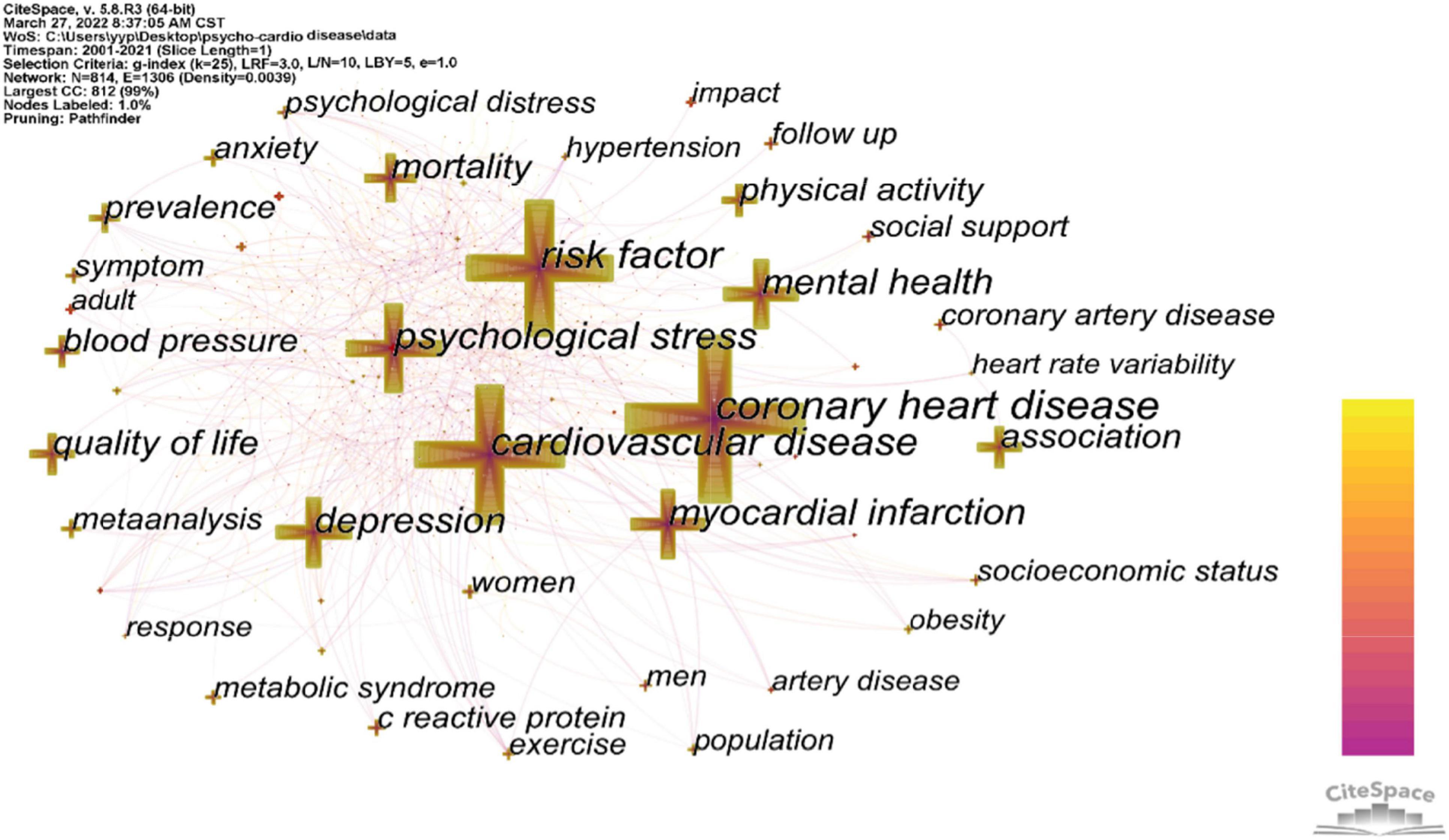
Figure 4. Network of the keywords in publications about the psycho-cardiological disease and related literature.
Figure 5 describes the clustering of 21 keywords based on the log-likelihood ratio (LLR) algorithm. To further refine the research content and better grasp the research hot spots, 21 clusters are divided into 6 parts, including target population (#0dementia), psychosocial risk factors (#1psychological factor, #4social support, #8men, #10age, #14posttraumatic stress, #19 socioeconomic status, #20bipolar disorder, and #17sex difference), intervention (#3quality of life and #16mortality), clinical trials (#5randomized controlled trial), pathogenesis (#11hemostasis and #15 corticotropin releasing hormone), and clinical manifestations (#13symptom).
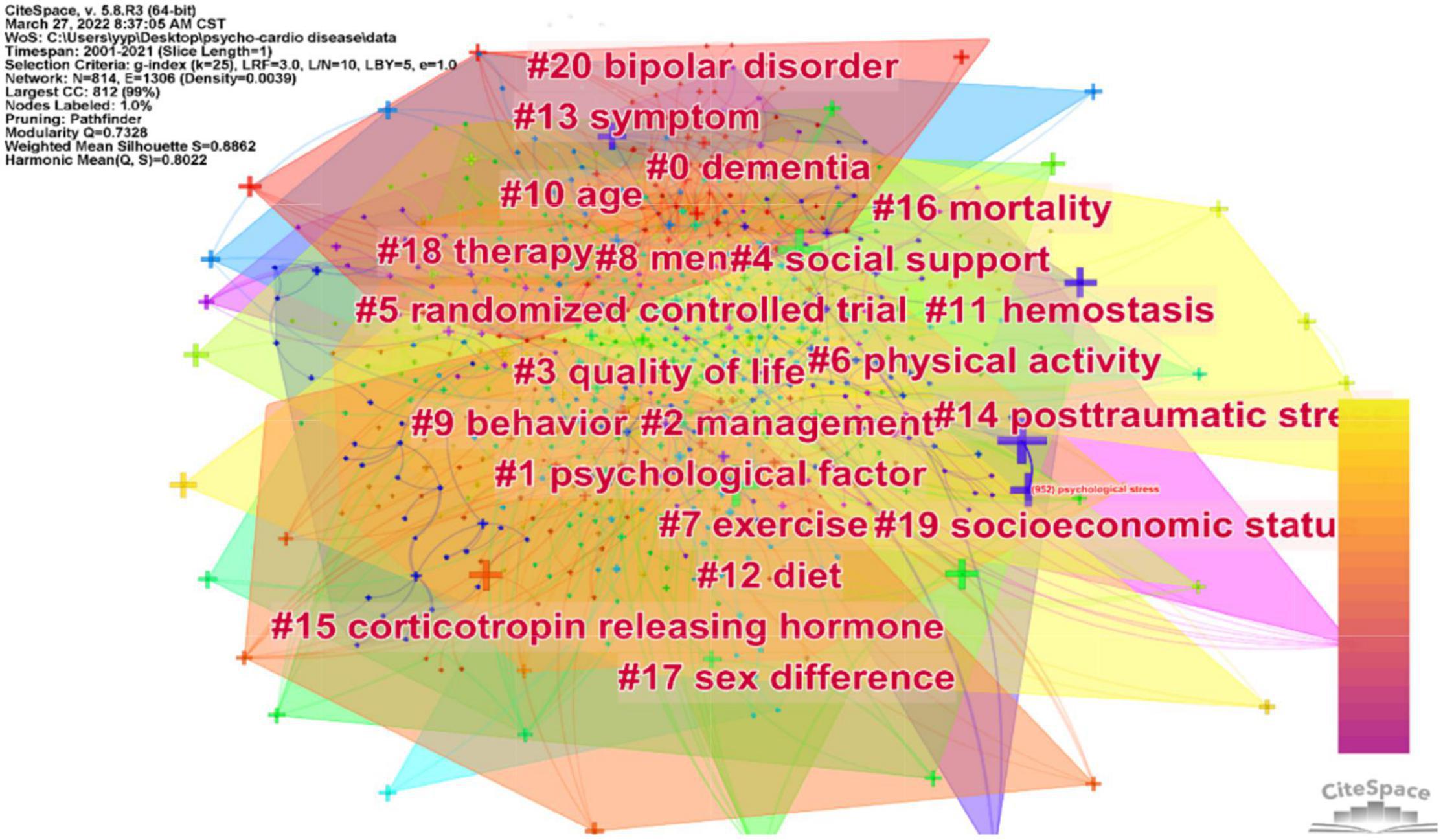
Figure 5. Network of the keyword clusters in publications about the psycho-cardiological disease and related literature.
First, it is worth mentioning the psychosocial risk factors in bi-heart diseases. Psychosocial risk factors mainly contain lack of social support (#4), low economic and social status (#19), stress at work and family, bipolar disorder (#20), posttraumatic stress disorder (#14), and psychological factor (#1), such as depression, anxiety, anger or hostility, gender differences (#17), and personality factors. All of the above risk factors increase the risk of CVDs (43–45). For example, depression is coupled with increased body mass index and obesity, an independent risk factor for CVDs (46, 47). In support of this opinion, Johnson and colleagues assessed patients’ mental health who lived with spontaneous coronary dissection and found significantly higher depression, anxiety, and posttraumatic stress disorder (48). In addition, reported data suggest that in epidemiology, women may have a larger share of depression-related CVDs, which is partly attributable to genetic factors (49).
Second, bi-heart disease aims to improve health-related quality of life and reduce mortality (#16). The main treatment measures (#18) include exercise therapy (#6, #7) and risk factor management (#12), which are effective clinical practices recommended by the U.S. Preventive Services Task Force to reduce CVD risk among high-risk individuals (50). Besides, these interventions are among the top five prescriptions for cardiac rehabilitation (51).
Third, in mechanism, it links inextricably to the imbalance of the hypothalamic–pituitary–adrenal axis (#15) and platelet activation (#11). Studies show that long-term chronic stress, such as depression and anxiety, can lead to hyperfunction of the HPA axis and excessive secretion of cortisol. In addition, it can also cause hyperlipidemia and hypertension and then leads to various CVDs (52). Chronic stress leads to platelet aggregation and contributes to develop CVDs, suggesting that platelet aggregation may increase the incidence of cardiovascular adverse events (53). The focus population in bi-heart disease is people caring for people with dementia, who are at higher risk for CVDs and should be paid attention to (27).
Finally, the field of bi-heart disease attaches great importance to clinically randomized controlled trials, which rank second in the evidence pyramid proposed by the Medical Center of State University of New York in 2001. In addition, it is in line with evidence-based medicine-level recommendations.
Analysis of Reference Co-citation
Co-citation analysis of documents refers to two or more papers being cited in the same document (54). Each node represents a cited article, and the node’s size reflects the proportion of citations it has received. Citations with citation bursts are shown in red rings, while nodes in purple rings have higher betweenness center values. By analyzing the clusters and key nodes in the collaborative citation network, the knowledge structure of the research field and its changes can be revealed. Figure 5 shows a co-citation network of bi-heart disease and related research references. As displayed in Figure 6, a circular node represents a reference, and the larger the node’s size, the more frequently the reference is cited. The purple-circled nodes in the network (BC is greater than 0.1) illustrate that they are pivotal turning points driving the field of bi-heart disease.
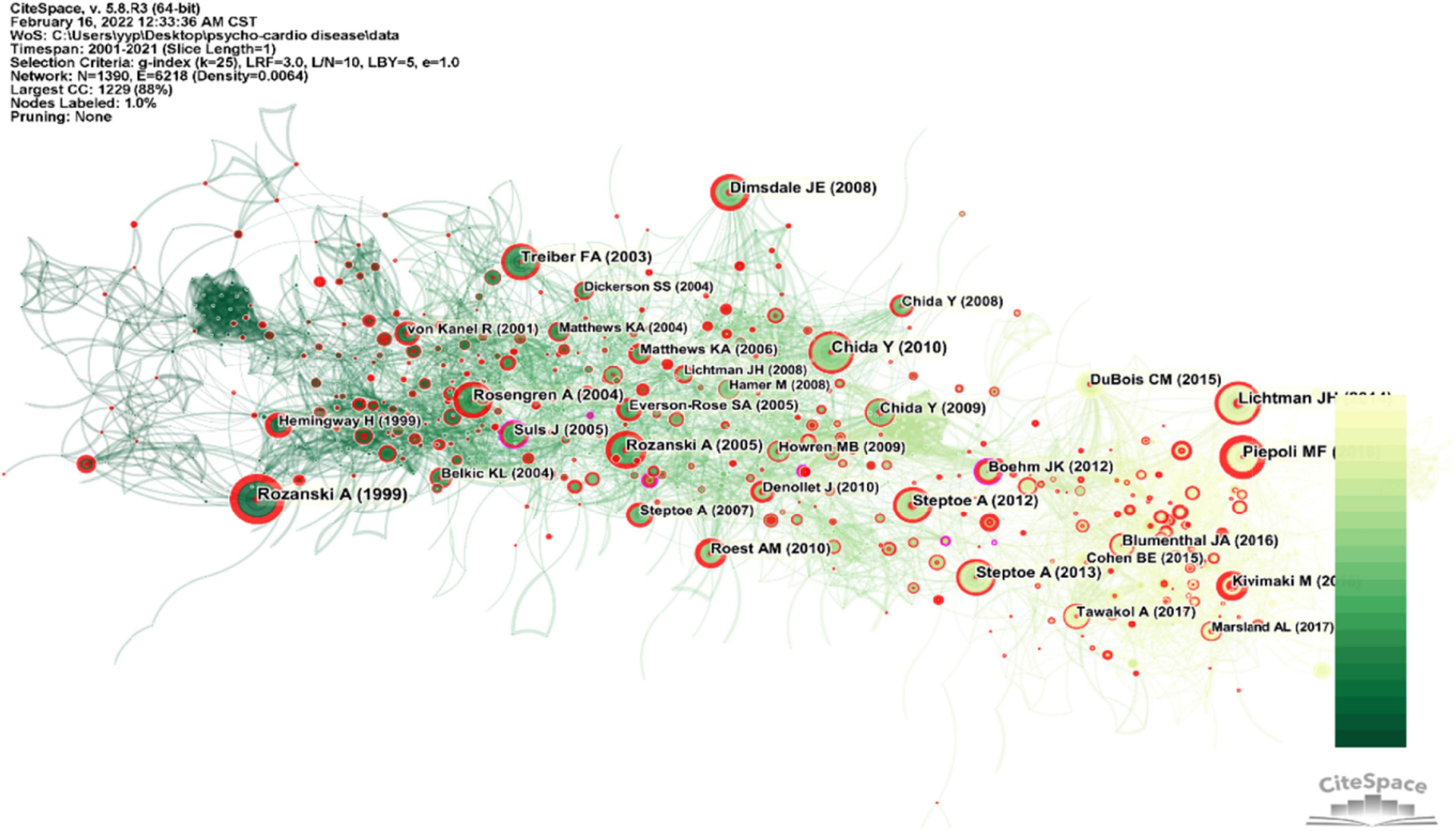
Figure 6. Co-citation network of references cited by publications about the psycho-cardiological disease and related literature.
The first turning point occurred in 2005. Before 2005, all the studies were on the relationship between adverse psychological factors, such as anxiety, depression, and hostility and health. However, after 2005, increasing evidence showed a protective association between positive psychological factors and physical health. Focusing on positive psychological wellbeing (PPWB) is associated with the most cardiovascular-related health behaviors [e.g., adequate sleep, fruit and vegetable intake, and biological mechanisms (inflammation and metabolic processes)] (55). It is consistent with the ideal cardiovascular health proposed by the American Heart Association in 2010. The second turning point occurred in 2010, i.e., a randomized clinical trial of cognitive-behavioral therapy for recurrent CVDs and recurrent myocardial infarction. The results suggest that cognitive-behavioral therapy can reduce the risk of recurrent CVDs and myocardial infarction compared with traditional treatment methods and can be included in the secondary prevention program for coronary heart disease (56). The third turning point occurred in 2012. As Fang, MD, noted that newly diagnosed cancer was traumatic stress, conducting a historical cohort study showed that cancer increased the patient’s suicide rate and the risk of cardiovascular events (57). All in all, these three turning points are virtual nodes to move the development of the field of bi-heart disease.
Furthermore, Cite Space can also display hot knowledge on bi-heart disease in a timeline view (shown in Figure 7). The network consists of highly cited references within a given slice of time. Nodes are sorted in the same lines by a clustering technique called brilliant local moving. Clusters are numbered so that groups containing more references are ranked higher (22). The color legend at the top shows that cooler-colored links and citations occurred in 2001, while hotter links and citations occurred closer to 2021. We can track the topic trend and time development research on psycho-cardiological diseases by referring to the legend. According to the timeline view, we can assume that the emphasis on studies related to the early bi-heart disease mainly focuses on drug treatment (#10), disease-related self-health evaluation (#2), psychological factors (#1 and #3), and psychophysiological characteristics (#7). Midterm gradually shifted to pathogenesis (#4, #12), disease predictors (#6), and hormones’ heart disease (#8). Later, it also focuses on the evaluation method of the disease (#0), personal health behavior (#5), cardiac rehabilitation (#9), and the new COVID-19 pandemic (#11).
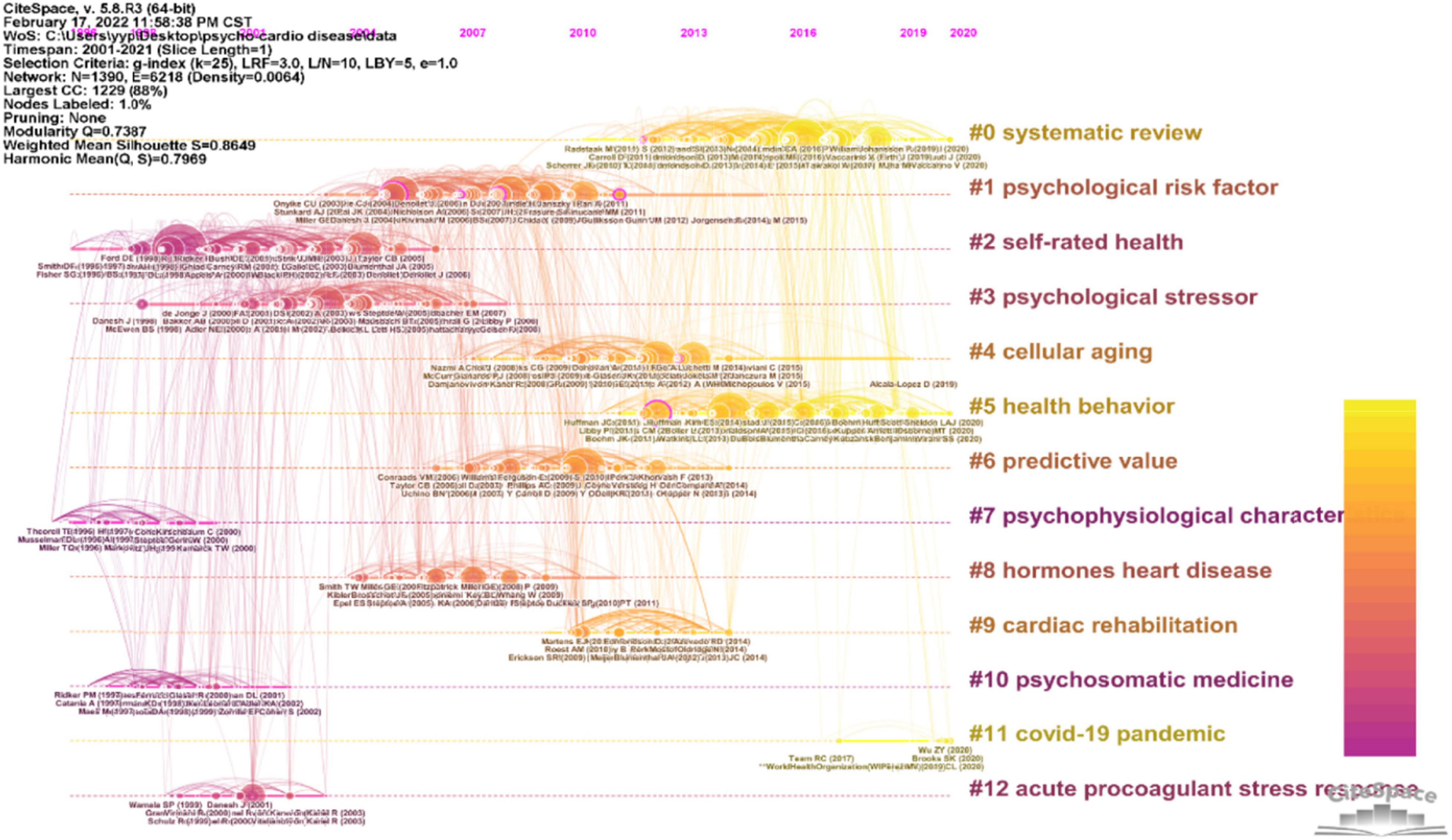
Figure 7. Timeline view of references cited by publications about the psycho-cardiological disease and related literature.
The first to note is the COVID-19 pandemic (#11). COVID-19 pandemic has swept the world, posing a threat to human health. Studies have shown that COVID-19 can lead to overwhelming stress, addiction to tobacco, alcohol, or increased obesity. “COVID-19 related depression” reflects the condition (58). Pressure from the coronavirus can lead to stress cardiomyopathy or an increased risk of heart failure (59). It reminds scientists and doctors worldwide to pay attention to the psychological-heart disease caused by the new coronary pneumonia virus.
The second one is cardiac rehabilitation (#9). From the simple drug treatment (#10) at the beginning, the treatment of bi-heart disease has gradually emphasized the importance of cardiac rehabilitation. In addition to treating the disease itself, it is also necessary to focus on the patient’s mental health and the ability to reintegrate into society. Studies have shown that cardiac rehabilitation has a good effect on chronic heart failure (60). In cardiac rehabilitation, there are five prescriptions, including drugs, exercise, nutrition, psychology (e.g., sleep management), and CVD risk factor management (e.g., smoking, alcohol, blood pressure, and obesity) (61). The most important core content is exercise. Traditional Chinese medicine exercises play a significant role in cardiac rehabilitation. There is evidence that tai chi improves cardiac function, quality of life, and anxiety and depression in patients with coronary artery disease (62). In addition, a randomized controlled trial shows the tai chi group had significantly lower blood pressure, lower blood glucose index, exercise self-efficacy, and perceived stress, and improved mental health compared to the brisk walking group with hypertension (63). In addition, healthy behavior (#5) is one of the quality evaluations of cardiac rehabilitation development. During the COVID-19 pandemic, cardiac rehabilitation is one of the effective treatments for patients with new coronary pneumonia complicated by psycho-cardiological disease (64).
Third, the current literature evaluation in psycho-cardiological disease is mainly a systematic review. The systematic review (#0) and meta-analysis are at the top of the 9th piece of evidence in the American pyramid, indicating that the research on bi-heart disease is consistent with evidence-based medical research, and the conclusion is reliable. At present, systematic review and meta-analysis are the more commonly used evaluation methods in psycho-cardiological disease (65–68).
Discussion
With the establishment of the biopsychosocial medicine model, medicine gradually shifted from disease-centered to integrated mind-body medicine, so psycho-cardiology was born, and psycho-cardiological disease was proposed. The forms of psycho-cardiological illness are divided into three types. The first type is psychological, emotional, and mental problems caused by symptoms similar to CVDs, such as chest tightness, chest pain, and palpitations. The second type is CVD combined with psychological issues. When the diagnosis is clear (coronary artery disease or heart failure connected with depression or anxiety), clinicians can quickly prescribe the proper medication. When the diagnosis is not precise (mostly arrhythmias), patients may also show negative psychological or emotional symptoms, such as anxiety and depression. For example, Brugada syndrome, long QT syndrome, hypertension, hyperthyroidism, and lifestyle factors, such as regular endurance exercise, can contribute to atrial fibrillation, affecting the patient’s quality of life and leading to potential initial depression (69–72).
The final form is a heart disease that undergoes certain stressful blows that cause psychological changes. Today some medical approaches may impact the quality of life or health of the patient. A recent study has shown that catheter ablation makes asymptomatic atrial fibrillation patients more health-conscious, which leads to better medication adherence, lower salt-sensitive hypertension, and thus improved cardiac function. It also reduced mental anxiety and activity limits, which helped improve the quality of life (73). However, another study suggests that anxiety and depression in patients with the acute coronary syndrome who underwent PCI were associated with increased length of hospital stay (74). Therefore, medical interventions have a two-sided impact on the patient’s quality of life and health, and clinicians should assess the patient’s psychological status.
In this review, an analysis of the literature in this article shows an overall upward trend in research on psycho-cardiological disease from 2001 to 2021, indicating an increasing interest in physical and mental disorders and the importance of psychological factors in disease. From the visual map of countries and authors, countries, such as the United States, the United Kingdom, Australia, and Italy, are the main research forces in bi-heart disease. It shows that the countries mentioned above have a high scientific output in this field, which helps relevant researchers to seek collaboration. In addition, several academic groups have formed, such as the Andrew Steptoe and Roland von Känel, MD, as the core academic group. However, research in this area is fragmented, and there is a lack of cooperation and anxiety between countries. Hence, it is necessary to strengthen international communication and collaboration in this field and form an interactive global cooperation network to promote in-depth research.
As can be seen from the subject categories, the field of bi-heart disease is a typical interdisciplinary subject, including clinical medicine and psychology, psychiatry, public health and occupational health, nursing, and pharmacology, which suggests that a growing number of people pay attention to bi-heart disease, not only in the screening and diagnosis of the disease but also in the treatment and care of the disease. Correspondingly, it is necessary to cultivate high-level compound medical talents. At the same time, a multidisciplinary collaborative disease management team should be formed, which is beneficial for the individualized and precise treatment of psycho-cardiological disease.
A visual map of keywords and co-cited references reflects hot spots and trends in bi-heart disease. First, from the keyword network mapping in this article, we can observe that coronary artery disease or myocardial infarction combined with anxiety and depression is more common. In contrast, atrial fibrillation combined with anxiety and depression accounts for a smaller proportion. It may be because the diagnosis of atrial fibrillation is relatively unclear. Second, the early bi-heart disease field focuses on the association between psychological factors and CVDs and the mechanisms. In addition, there are three hot spots of research on psychosocial risk factors, priority populations, including Alzheimer’s disease dementia caregivers, patients with cancer, and elderly, and interventions, such as exercise and diet. It is worth being concerned about the exercise therapy. Regular exercise can improve the patient’s cardiovascular symptoms and psychological status, while prolonged endurance exercise can lead to adverse cardiovascular events, such as atrial fibrillation (72). Therefore, low-to-moderate intensity exercises, such as tai chi and Baduanjin, in cardiac rehabilitation are recommended.
Third, the frontiers of current research are evaluation methods, such as systematic reviews and meta-analyses, COVID-19 populations, cardiac rehabilitation, and healthy behaviors. Finally, three turning points must be mentioned, the first in 2005 focusing on positive psychological factors being protective against CVD, the second in 2010 with a focus on cognitive-behavioral therapy, and the third in 2012. The turning point is that patients with cancer are susceptible to stress cardiomyopathy.
Limitation
A limitation of this study is that it only uses the WOS database. It is mainly the limitation of the Cite Space software itself. The citation and quoted information in scientific texts reflect the flow and dissemination of scientific knowledge, an essential theoretical basis for knowledge mapping. Most of the current visualization tools are developed based on WOS. WOS is the most representative and widely used in this field, so it is used. Besides, Cite Space software can only analyze a single database. For these reasons, the literature search in this study was not comprehensive, which may cause biased results.
Conclusion
People are increasingly concerned about the harmony and health of the mind and body. Research in psycho-cardiological disease focuses on psychosocial factors, priority populations, such as Alzheimer’s disease dementia caregivers, elderly, and patients with cancer, and interventions, such as exercise therapy. In addition, there are three future research frontiers. One is psychological heart disease in patients with COVID-19, the second is cardiac rehabilitation, especially exercise treatment and health behavior evaluation, and the final one is an evidence-based medical evaluation.
Author Contributions
YH, QH, and YY designed the research plan and revised the manuscript. YY, XS, and XZ wrote the manuscript. SF, RC, and WX were responsible for the use of software and document retrieval. All authors contributed to the article and approved the submitted version.
Funding
This study was financially supported by the grant of Beijing Administration of Traditional Chinese Medicine (Grant No: The Capital Health Research and Development of Special 2022-1-4153) and the China Academy of Chinese Medical Sciences (Grant No. CI2021A00918).
Conflict of Interest
The authors declare that the research was conducted in the absence of any commercial or financial relationships that could be construed as a potential conflict of interest.
Publisher’s Note
All claims expressed in this article are solely those of the authors and do not necessarily represent those of their affiliated organizations, or those of the publisher, the editors and the reviewers. Any product that may be evaluated in this article, or claim that may be made by its manufacturer, is not guaranteed or endorsed by the publisher.
Acknowledgments
We thank Prof. Chao Mei Chen for developing Cite Space and having public access to it for free.
Footnotes
References
1. Lai M, Shen T, Cui H, Lin L, Ran P, Huo P, et al. Clinical outcomes and survival analysis in patients with psycho-cardiological disease: a retrospective analysis of 132 cases. J Int Med Res. (2021) 49:0300060521990984. doi: 10.1177/0300060521990984
2. Angaw DA, Ali R, Tadele A, Shumet S. The prevalence of cardiovascular disease in Ethiopia: a systematic review and meta-analysis of institutional and community-based studies. BMC Cardiovasc Disord. (2021) 21:37. doi: 10.1186/s12872-020-01828-z
3. Roth GA, Mensah GA, Johnson CO, Addolorato G, Ammirati E, Baddour LM, et al. Global burden of cardiovascular diseases and risk factors, 1990–2019: update from the GBD 2019 study. J Am College Cardiol. (2020) 76:2982–3021. doi: 10.1016/j.jacc.2020.11.010
4. Mokdad AH, Ballestros K, Echko M, Glenn S, Olsen HE, Mullany E, et al. The State of US Health, 1990-2016 burden of diseases, injuries, and risk factors among US States. JAMA J Am Med Assoc. (2018) 319:1444–72. doi: 10.1001/jama.2018.0158
5. Benjamin EJ, Muntner P, Alonso A, Bittencourt MS, Callaway CW, Carson AP, et al. Heart disease and stroke statistics-2019 update a report from the American Heart Association. Circulation. (2019) 139:E56–528.
6. Flack JM, Calhoun D, Schiffrin EL. The new ACC/AHA hypertension guidelines for the prevention, detection, evaluation, and management of high blood pressure in adults. Am J Hypertens. (2018) 31:133–5. doi: 10.1093/ajh/hpx207
7. Yang W, Dall TM, Beronjia K, Lin J, Semilla AP, Chakrabarti R, et al. Economic costs of diabetes in the US in 2017. Diabetes Care. (2018) 41:917–28. doi: 10.2337/dci18-0007
8. Ma L, Wang W, Wu Y, Chen W. A12514 outline of the report on cardiovascular diseases in China, 2017. J Hypertens. (2018) 36:E322.
9. Charlson FJ, Moran AE, Freedman G, Norman RE, Stapelberg NJ, Baxter AJ, et al. The contribution of major depression to the global burden of ischemic heart disease: a comparative risk assessment. BMC Med. (2013) 11:250. doi: 10.1186/1741-7015-11-250
10. Park DH, Cho JJ, Yoon JL, Kim MY, Ju YS. The impact of depression on cardiovascular disease: a nationwide population-based cohort study in Korean elderly. Korean J Fam Med. (2020) 41:299–305. doi: 10.4082/kjfm.18.0134
11. Dennis J, Sealock J, Levinson RT, Farber-Eger E, Franco J, Fong S, et al. Genetic risk for major depressive disorder and loneliness in sex-specific associations with coronary artery disease. Mol Psychiatry. (2021) 26:4254–64. doi: 10.1038/s41380-019-0614-y
12. Zalewska M. Co-occurrence of depressive disorders and cardiovascular diseases - selected aspects. Psychiatria I Psychol Kliniczna J Psychiatry Clin Psychol. (2020) 20:183–90. doi: 10.15557/pipk.2020.0023
13. Kwak Y, Kim Y, Kwon SJ, Chung H, Health P. Mental health status of adults with cardiovascular or metabolic diseases by gender. Int J Environ Res Public Health. (2021) 18:514. doi: 10.3390/ijerph18020514
14. AbuRuz ME. Anxiety and depression predicted quality of life among patients with heart failure. J Multidisciplinary Healthcare. (2018) 11:367. doi: 10.2147/JMDH.S170327
15. Hamatani Y, Iguchi M, Ikeyama Y, Kunugida A, Ogawa M, Yasuda N, et al. Prevalence, temporal change, and determinants of anxiety and depression in hospitalized patients with heart failure. J Cardiac Failure. (2022) 28:181–90. doi: 10.1016/j.cardfail.2021.07.024
16. Koleck TA, Mitha SA, Biviano A, Caceres BA, Corwin EJ, Goldenthal I, et al. Exploring depressive symptoms and anxiety among patients with atrial fibrillation and/or flutter at the time of cardioversion or ablation. J Cardiovasc Nurs. (2021) 36:470–81. doi: 10.1097/JCN.0000000000000723
17. Walters TE, Wick K, Tan G, Mearns M, Joseph SA, Morton JB, et al. Psychological distress and suicidal ideation in patients with atrial fibrillation: prevalence and response to management strategy. J Am Heart Assoc. (2018) 7:e005502. doi: 10.1161/JAHA.117.005502
18. Ai Y, Xing Y, Yan L, Ma D, Gao A, Xu Q, et al. Atrial fibrillation and depression: a bibliometric analysis from 2001 to 2021. Front Cardiovasc Med. (2022) 9:775329. doi: 10.3389/fcvm.2022.775329
19. Zhou Y, Zhu X-P, Shi J-J, Yuan G-Z, Yao Z-A, Chu Y-G, et al. Coronary heart disease and depression or anxiety: a bibliometric analysis. Front Psychol. (2021) 12:669000. doi: 10.3389/fpsyg.2021.669000
20. Chen C, Hu Z, Liu S, Tseng H. Emerging trends in regenerative medicine: a scientometric analysis in CiteSpace. Expert Opin Biol Ther. (2012) 12:593–608. doi: 10.1517/14712598.2012.674507
21. Li J, Chen C. CiteSpace: Text Mining and Visualization in Scientific Literature. Beijing: Business Press (2016). p. 149–52.
22. Zhu Y, Kim MC, Chen C. An investigation of the intellectual structure of opinion mining research. Inform Res Int Electron J. (2017) 22:739.
23. Qin Y, Zhang Q, Liu Y. Analysis of knowledge bases and research focuses of cerebral ischemia-reperfusion from the perspective of mapping knowledge domain. Brain Res Bull. (2020) 156:15–24. doi: 10.1016/j.brainresbull.2019.12.004
24. Liang Y-D, Li Y, Zhao J, Wang X-Y, Zhu H-Z, Chen X-H. Study of acupuncture for low back pain in recent 20 years: a bibliometric analysis via CiteSpace. J Pain Res. (2017) 10:951. doi: 10.2147/JPR.S132808
25. Wu L, Huang Z, Pan Z. The spatiality and driving forces of population ageing in China. PLoS One. (2021) 16:e0243559. doi: 10.1371/journal.pone.0243559
26. Bei Y, Yang T, Xiao J. Cardiovascular medicine in China: what can we do to achieve the Healthy China 2030 plan? BMC Med. (2018) 16:132. doi: 10.1186/s12916-018-1133-4
27. Jun YAO, Wenyuan WU, Chunbo LI. A preliminary study of quality of life in patients with type 2 diabetes mellitus coexisting major depression. Chin J Behav Med Sci. (2006) 15:323–5.
28. Camacho-Conde JA, Galán-López JMJD, Disorders GC. Depression and cognitive impairment in institutionalized older adults. Dementia Geriatric Cogn Disord. (2020) 49:107–20. doi: 10.1159/000508626
29. Jerez-Roig J, Oliveira ND, Fagundes D, Amanda DF, Matias M, Ferreira LM, et al. Depressive symptoms and associated factors in institutionalized elderly. Exp Aging Res. (2016) 42:479–91. doi: 10.1080/0361073X.2016.1224673
31. Steptoe A, Molloy GJ, Messerly-Buergy N, Wikman A, Randall G, Perkins-Porras L, et al. Emotional triggering and low socio-economic status as determinants of depression following acute coronary syndrome. Psychol Med. (2011) 41:1857–66. doi: 10.1017/S0033291710002588
32. Steptoe A, Strike PC, Perkins-Porras L, McEwan JR, Whitehead DL. Acute depressed mood as a trigger of acute coronary syndromes. Biol Psychiatry. (2006) 60:837–42. doi: 10.1016/j.biopsych.2006.03.041
33. Pogosova N, Saner H, Pedersen SS, Cupples ME, McGee H, Hoefer S, et al. Psychosocial aspects in cardiac rehabilitation: from theory to practice. A position paper from the Cardiac Rehabilitation Section of the European Association of Cardiovascular Prevention and Rehabilitation of the European Society of Cardiology. Eur J Prevent Cardiol. (2015) 22:1290–306. doi: 10.1177/2047487314543075
34. von Kaenel R, Kudielka BM, Helfricht S, Metzenthin P, Preckel D, Haeberli A, et al. Effects of aspirin and propranolol on the acute psychological stress response in factor VIII coagulant activity: a randomized, double-blind, placebo-controlled experimental study. Blood Coagulation Fibrinolysis. (2008) 19:75–81. doi: 10.1097/MBC.0b013e3282f38c4e
35. Von Känel R, Dimsdale JE, Mills PJ, Ancoli-Israel S, Patterson TL, Mausbach BT, et al. Effect of Alzheimer caregiving stress and age on frailty markers interleukin-6, C-reactive protein, and D-dimer. J Gerontol Series A Biol Sci Med Sci. (2006) 61:963–9. doi: 10.1093/gerona/61.9.963
36. Gaugler J, James B, Johnson T, Marin A, Weuve J. 2020 Alzheimer’s disease facts and figures. Alzheimers Dementia. (2020) 16:391–460. doi: 10.1002/alz.12068
37. Känel R, Mausbach BT, Patterson TL, Dimsdale JE, Aschbacher K, Mills PJ, et al. Increased Framingham coronary heart disease risk score in dementia caregivers relative to non-caregiving controls. Gerontology. (2008) 54:131–7. doi: 10.1159/000113649
38. Mausbach BT, Patterson TL, Rabinowitz YG, Grant I, Schulz R. Depression and distress predict time to cardiovascular disease in dementia caregivers. Health Psychol. (2007) 26:539. doi: 10.1037/0278-6133.26.5.539
39. Dentino AN, Pieper CF, Rao KMK, Currie MS, Harris T, Blazer DG, et al. Association of interleukin-6 and other biologic variables with depression in older people living in the community. J Am Geriatrics Soc. (1999) 47:6–11. doi: 10.1111/j.1532-5415.1999.tb01894.x
40. Xu XY, Kwan RYC, Leung AYM. Behavioural activation for family dementia caregivers: a systematic review and meta-analysis. Geriatric Nurs. (2020) 41:544–52. doi: 10.1016/j.gerinurse.2020.02.003
41. Moore RC, Chattillion EA, Ceglowski J, Ho J, von Känel R, Mills PJ, et al. A randomized clinical trial of Behavioral Activation (BA) therapy for improving psychological and physical health in dementia caregivers: results of the Pleasant Events Program (PEP). Behav Res Ther. (2013) 51:623–32. doi: 10.1016/j.brat.2013.07.005
42. Yuan G, Shi J, Jia Q, Shi S, Zhu X, Zhou Y, et al. Cardiac rehabilitation: a bibliometric review from 2001 to 2020. Front Cardiovasc Med. (2021) 8:672913. doi: 10.3389/fcvm.2021.672913
43. Vathesatogkit P, Batty GD, Woodward M. Socioeconomic disadvantage and disease-specific mortality in Asia: systematic review with meta-analysis of population-based cohort studies. Epidemiol Community Health. (2014) 68:375–83. doi: 10.1136/jech-2013-203053
44. Kivimaeki M, Nyberg ST, Batty GD, Fransson EI, Heikkila K, Alfredsson L, et al. Job strain as a risk factor for coronary heart disease: a collaborative meta-analysis of individual participant data. Lancet. (2012) 380:1491–7. doi: 10.1016/S0140-6736(12)60994-5
45. Barth J, Schneider S, von Kaenel R. Lack of social support in the etiology and the prognosis of coronary heart disease: a systematic review and meta-analysis. Psychosomatic Med. (2010) 72:229–38. doi: 10.1097/PSY.0b013e3181d01611
46. Carney RM, Freedland KE, Miller GE, Jaffe AS. Depression as a risk factor for cardiac mortality and morbidity - A review of potential mechanisms. J Psychosomatic Res. (2002) 53:897–902. doi: 10.1016/s0022-3999(02)00311-2
47. Pine DS, Goldstein RB, Wolk S, Weissman MM. The association between childhood depression and adulthood body mass index. Pediatrics. (2001) 107:1049–56. doi: 10.1542/peds.107.5.1049
48. Johnson AK, Hayes SN, Sawchuk C, Johnson MP, Best PJ, Gulati R, et al. Analysis of posttraumatic stress disorder, depression, anxiety, and resiliency within the unique population of spontaneous coronary artery dissection survivors. J Am Heart Assoc. (2020) 9:e014372. doi: 10.1161/JAHA.119.014372
49. Mulle JG, Vaccarino V. Cardiovascular disease, psychosocial factors, and genetics: the case of depression. Progr Cardiovasc Dis. (2013) 55:557–62. doi: 10.1016/j.pcad.2013.03.005
50. Lobelo F, Supapannachart KJ, Zhou T. Exercise and diet counseling trends from 2002 to 2015: a serial cross-sectional study of U.S. adults with cardiovascular disease risk - sciencedirect. Am J Prevent Med. (2020) 60:e59–67. doi: 10.1016/j.amepre.2020.07.008
51. Thomas RJ, Beatty AL, Beckie TM, Brewer LC, Brown TM, Forman DE, et al. Home-based cardiac rehabilitation a scientific statement from the American association of cardiovascular and pulmonary rehabilitation, the American heart association, and the American college of cardiology. J Am College Cardiol. (2019) 74:133–53.
52. Kemp AH, Brunoni AR, Santos IS, Nunes MA, Dantas EM, Carvalho de Figueiredo R, et al. Effects of depression, anxiety, comorbidity, and antidepressants on resting-state heart rate and its variability: an ELSA-Brasil cohort baseline study. Am J Psychiatry. (2014) 171:1328–34. doi: 10.1176/appi.ajp.2014.13121605
53. Matsuhisa F, Kitamura N, Satoh E. Effects of acute and chronic psychological stress on platelet aggregation in mice. Stress. (2014) 17:186–92. doi: 10.3109/10253890.2014.888548
54. Small H. Co-citation in scientific literature-new measure of relationship between 2 documents. J Am Soc Inform Sci. (1973) 24:265–9. doi: 10.1002/asi.4630240406
55. Diener E, Chan MY. Happy people live longer: subjective well-being contributes to health and longevity. Appl Psychol Health Well Being. (2011) 3:1–43. doi: 10.1111/j.1758-0854.2010.01045.x
56. Gulliksson M, Burell G, Wessby B, Lundin L, Toss H, Svardsudd K. Randomized controlled trial of cognitive behavioral therapy vs standard treatment to prevent recurrent cardiovascular events in patients with coronary heart disease. Eur Heart J. (2011) 32:390. doi: 10.1001/archinternmed.2010.510
57. Fang F, Fall K, Mittleman MA, Sparén P, Ye W, Adami H-O, et al. Suicide and cardiovascular death after a cancer diagnosis. N Engl J Med. (2012) 366:1310–8. doi: 10.1056/nejmoa1110307
58. Komiyama M, Hasegawa K. Coronavirus Disease 2019: psychological stress and cardiovascular diseases. Eur Cardiol Rev. (2021) 16:e33. doi: 10.15420/ecr.2021.10
59. Koutroumpakis E, Taylor T, Damaraju S, Mawji SB. “Covidsubo”: stress-induced cardiomyopathy by novel coronavirus disease 2019. Cardiology. (2020) 145:779–83. doi: 10.1159/000511450
60. Zhang M, Wang K, Liu Cheng Y. Research progress in exercise-based cardiac rehabilitation in chronic heart failure patients. Chin J Geriatrics. (2020) 39:1099–103.
61. Cowie A, Buckley J, Doherty P. Standards and core components for cardiovascular disease prevention and rehabilitation. Heart. (2019) 105:510–5. doi: 10.1136/heartjnl-2018-314206
62. Li Y, Zhang H, Wang Y. Tai Chi ameliorates coronary heart disease by affecting serum levels of miR-24 and miR-155. Front Physiol. (2019) 10:587. doi: 10.3389/fphys.2019.00587
63. Chan AWK, Chair SY, Lee DTF, Leung DYP, Sit JWH, Cheng HY, et al. Tai Chi exercise is more effective than brisk walking in reducing cardiovascular disease risk factors among adults with hypertension: a randomised controlled trial. Int J Nurs Stud. (2018) 88:44–52. doi: 10.1016/j.ijnurstu.2018.08.009
64. Goulart CDL, Silva RN, Oliveira MR, Guizilini S, Rocco IS, Mendez VMF, et al. Lifestyle and rehabilitation during the COVID-19 pandemic: guidance for health professionals and support for exercise and rehabilitation programs. Expert Rev Anti Infect Ther. (2021) 19:1385–96. doi: 10.1080/14787210.2021.1917994
65. Albus C, Herrmanna RN, Oliveira MR, Guizilini S, Rocco IS, Mendez VMF, et al. Lifestyle and rehabilitat of psychological interventions on subjective and objective outcomes compared with exercise based cardiac rehabilitation alone in patients with cardiovascular disease: a systematic review and meta-analysis. Eur J Prevent Cardiol. (2019) 26:1035–49. doi: 10.1177/2047487319832393
66. Krittanawong C, Maitra NS, Virk HUH, Fogg S, Wang Z, Kaplin S, et al. Association of optimism with cardiovascular events and all-cause mortality: systematic review and meta-analysis. Am J Med. (2022): [Online ahead of print] doi: 10.1016/j.amjmed.2021.12.02
67. Magán I, Casado L, Jurado-Barba R, Barnum H, Redondo MM, Hernandez AV, et al. Efficacy of psychological interventions on psychological outcomes in coronary artery disease: systematic review and meta-analysis. Psychol Med. (2021) 51:1846–60. doi: 10.1017/s0033291720000598
68. Richards SH, Anderson L, Jenkinson CE, Whalley B, Rees K, Davies P, et al. Psychological interventions for coronary heart disease: cochrane systematic review and meta-analysis. Eur J Prevent Cardiol. (2018) 25:247–59.
69. Vlachos K, Mascia G, Martin CA, Bazoukis G, Frontera A, Cheniti G, et al. Atrial fibrillation in Brugada syndrome: current perspectives. J Cardiovasc Electrophysiol. (2020) 31:975–84. doi: 10.1111/jce.14361
70. Mascia G, Arbelo E, Solimene F, Giaccardi M, Brugada R, Brugada J. The long-QT syndrome and exercise practice: the never-ending debate. J Cardiovasc Electrophysiol. (2018) 29:489–96. doi: 10.1111/jce.13410
71. Mont L, Elosua R, Brugada JJE. Endurance sport practice as a risk factor for atrial fibrillation and atrial flutter. Europace. (2009) 11:11–7. doi: 10.1093/europace/eun289
72. Frost L, Vestergaard P, Mosekilde L. Hyperthyroidism and risk of atrial fibrillation or flutter: a population-based study. Arch Intern Med. (2004) 164:1675–8. doi: 10.1001/archinte.164.15.1675
73. Onishi N, Kyo S, Oi M, Jinnai T, Kuroda M, Shimizu Y, et al. Improvement in quality of life and cardiac function after catheter ablation for asymptomatic persistent atrial fibrillation. J Arrhythm Arch Internal Med. (2021) 37:11–9. doi: 10.1002/joa3.12457
Keywords: psycho-cardiological disease, cardiovascular diseases, mapping knowledge domains, cite space software, bibliometric analysis
Citation: You Y, Shou X, Zhang X, Fan S, Chai R, Xue W, Hu Y and He Q (2022) Psycho-Cardiological Disease: A Bibliometric Review From 2001 to 2021. Front. Cardiovasc. Med. 9:890329. doi: 10.3389/fcvm.2022.890329
Received: 05 March 2022; Accepted: 04 April 2022;
Published: 29 April 2022.
Edited by:
Chayakrit Krittanawong, NYU Grossman School of Medicine, United StatesReviewed by:
Deirdre McLaughlin, The University of Melbourne, AustraliaLuigia Brugliera, San Raffaele Scientific Institute (IRCCS), Italy
Giuseppe Mascia, San Martino Hospital (IRCCS), Italy
Liliane Lins-Kusterer, Universidade Federal da Bahia, Brazil
Jahaira Lopez-Pastrana, Thomas Jefferson University Hospital, United States
Copyright © 2022 You, Shou, Zhang, Fan, Chai, Xue, Hu and He. This is an open-access article distributed under the terms of the Creative Commons Attribution License (CC BY). The use, distribution or reproduction in other forums is permitted, provided the original author(s) and the copyright owner(s) are credited and that the original publication in this journal is cited, in accordance with accepted academic practice. No use, distribution or reproduction is permitted which does not comply with these terms.
*Correspondence: Yuanhui Hu, aHVpeXVodWk1NUBzb2h1LmNvbQ==; Qingyong He, aGVxaW5neW9uZ0AxNjMuY29t
†These authors have contributed equally to this work and share first authorship
 Yaping You
Yaping You Xintian Shou
Xintian Shou Xuesong Zhang
Xuesong Zhang Shaowei Fan
Shaowei Fan Ruoning Chai
Ruoning Chai Wenjing Xue
Wenjing Xue Yuanhui Hu
Yuanhui Hu Qingyong He1*
Qingyong He1*
